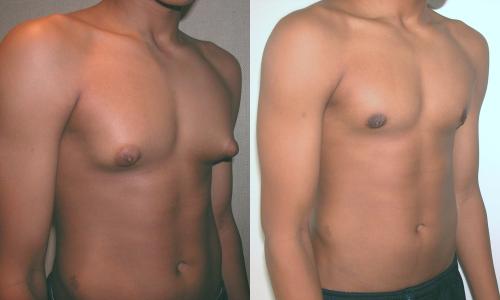GYNECOMASTIA

Definition: Gynecomastia is the development of abnormally large mammary glands in males resulting in breast enlargement. Milk production may or may not occur. [2]
The condition can occur in neonates (due to female hormones from the mother; this is called witches’ milk), in adolescence, and in the elderly. Of course, in adolescent boys the condition is often a source of distress due to social implications. [1] Pubertal hypertrophy is characterized by a tender discoid enlargement of the breast tissue beneath the areola (nipple) and usually resolves all on it’s own within a year. [2]
Causes
A number of researchers believe that in many cases the cause of gynecomastia is an altered androgen/estrogen ratio that causes changes in the cells of breast tissue. [2] This could be due to:
- decrease in production of androgen (steroids)
- increase in estrogen formation or production
- decrease in sensitivity of breast tissue to androgens
Also, certain medications can promote breast growth because they change the natural levels of testosterone and estrogen. Gynecomastia is a common side effect of estrogen treatment (for example in patients with prostate cancer). Other then hormones drugs that may cause gynecomastia include:
- Antiandrogens or androgen-synthesis inhibitors
- Antibiotics (isoniazid, ketoconazole, metronidazole)
- Anti-ulcer medications such as cimetidine
- Cancer chemotherapeutics, especially alkylating agents
- Cardiovascular drugs, such as captopril and digitoxin
- Psychoactive agents, including social drugs like marijuana.
- Penicillamine
In a few patients gynecomastia may be caused by a hormone-secreting tumor of the breast, lung, or other organ. In this case a biopsy may be performed to identify if the tumor is cancerous. [2]
Alcohol and drugs can also cause gynecomastia by mimicking estrogen and stimulating androgen production. Steroids are sometimes converted by the body into estrogens and can cause formation of male breasts. [3]
Prognosis
Gynecomastia is usually temporary and benign due to hormonal imbalance. However, gynecomastia can be the first sign of a serious disorder such as a testicular tumor, so patients should see their doctor. [2] To reverse breast growth, it may be as easy as changing or discontinuing medications.
Men over the age of 50 tend to produce fewer androgens and to gain fat tissue that converts androgen into estrogen, resulting in increased gynecomastia in that age group. In 3 percent of reported cases, gynecomastia can signal lung, liver, or adrenal cancer. [3]
Gynecomastia and Peptic Ulcer Therapy
Gynecomastia has been frequently associated as a side effect of cimetidine (Tagamet) for stomach ulcers and also with omeprazole (Prilosec). A British research group studied men who received such prescriptions for these types of ulcer medications over a four-year period. More than 81,000 men received at least one prescription for cimetidine, misoprostol, omeprazole or ranitidine. During the case study gynecomastia developed in 153 men and the majority (84 percent) of cases were self-reported by patients. In 46% of patients the condition regressed fully and in 18% partial regression occurred. [3] These findings revealed the risk of gynecomastia was substantially increased with cimetidine use but not with the other three drugs. This was influenced by daily dosage. [3]
Treatment of Gynecomastia
There are several treatments for gynecomastia, and most importantly is the cause of the disorder. If the gynecomastia is drug-induced, discontinuance of the drug may be all that is needed. Gynecomastia due to hyperthyroidism or other underlying disorders may resolve in response to therapy for the underlying disorder. Mild, asymptomatic gynecomastia detected through physical examination requires no therapy. [3]
In general, the indications for treatment include: marked pain and tenderness, severe embarrassment or emotional disturbance, most commonly seen in teens.
The most effective therapy at any stage is surgical removal of the tissue through a periareolar incision. In patients with a large amount of adipose tissue a suction-assisted lipectomy may be performed at the time of surgery to improve the cosmetic results. [3]
Questions To Ask Your Doctor About Gynecomastia
What is the cause of my gynecomastia? Is it a hormonal problem, drug related, or related to some other underlying cause?
How can you rule out a serious disorder such as testicular or breast cancer?
Under what circumstances would surgical correction be indicated? [3]
Treatment of Gynecomastia – Surgery
Surgery, liposuction or a combination of the two may be used to treat enlarged breasts. Surgery can reconstruct the contour of the chest and biopsy of the chest can be done to see if the tissue is cancerous. Enlargement typically occurs on both sides of the chest, and one sided breast enlargement is more likely for male breast cancer. [4] Consult with a board-certified plastic surgeon to determine if you are a good candidate for male breast reduction. Male breast reduction may be discouraged in overweight patients or if the patient uses drugs that may cause the condition. [4]
According to statistics from both the American Society for Aesthetic Plastic Surgery and the American Society of Plastic Surgeons, the national average for plastic surgeon fees for gynecomastia surgery is roughly $3,400. In most cases, the cost of male breast reduction surgery is not covered by insurance. [4]


